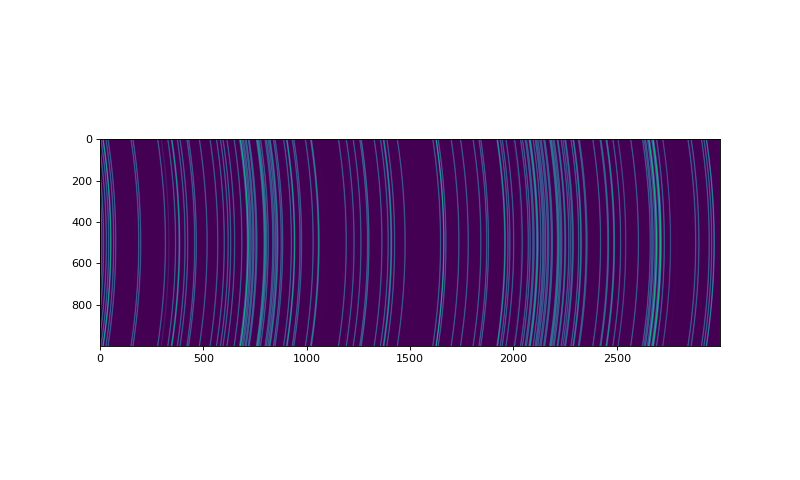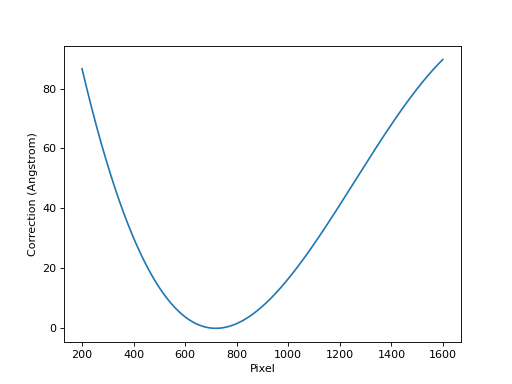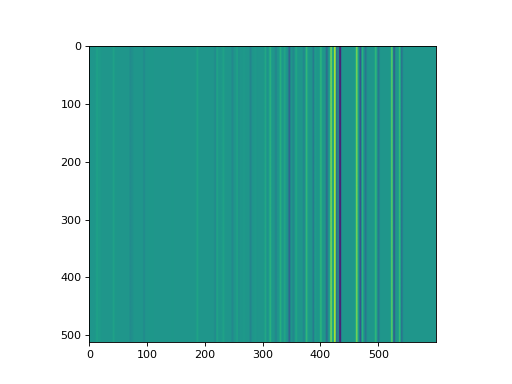make_2d_arc_image¶
- specreduce.utils.synth_data.make_2d_arc_image(nx=3000, ny=1000, wcs=None, extent=[3500, 7000], wave_unit=Unit('Angstrom'), wave_air=False, background=5, line_fwhm=5.0, linelists=['HeI'], amplitude_scale=1.0, tilt_func=None, add_noise=True)[source]¶
Create synthetic 2D spectroscopic image of reference emission lines, e.g. a calibration arc lamp. Currently, linelists from
pypeitare supported and are selected by string or list of strings that is passed toload_pypeit_calibration_lines. If awcsis not provided, one is created usingextentandwave_unitwith dispersion along the X axis.- Parameters:
- nxint (default=3000)
Size of image in X axis which is assumed to be the dispersion axis
- nyint (default=1000)
Size of image in Y axis which is assumed to be the spatial axis
- wcs
WCSinstance or None (default: None) 2D WCS to apply to the image. Must have a spectral axis defined along with appropriate spectral wavelength units.
- extent2-element list-like
If
wcsis not provided, this defines the beginning and end wavelengths of the dispersion axis.- wave_unit
Unit If
wcsis not provided, this defines the wavelength units of the dispersion axis.- wave_airbool (default: False)
If True, convert the vacuum wavelengths used by
pypeitto air wavelengths.- backgroundint (default=5)
Level of constant background in counts
- line_fwhmfloat (default=5)
Gaussian FWHM of the emission lines in pixels
- linelistsstr or list of str (default: [‘HeI’])
Specification for linelists to load from
pypeit- amplitude_scalefloat (default: 1)
Scale factor to apply to amplitudes provided in the linelists
- tilt_func1D polynomial from
polynomial The tilt function to apply along the cross-dispersion axis to simulate tilted or curved emission lines.
- add_noisebool (default=True)
If True, add Poisson noise to the image; requires
photutilsto be installed.
- Returns:
- ccd_im
CCDData CCDData instance containing synthetic 2D spectroscopic image
- ccd_im
Examples
This is an example of modeling a spectrograph whose output is curved in the cross-dispersion direction:
import matplotlib.pyplot as plt import numpy as np from astropy.modeling import models import astropy.units as u from specreduce.utils.synth_data import make_2d_arc_image model_deg2 = models.Legendre1D(degree=2, c0=50, c1=0, c2=100) im = make_2d_arc_image( linelists=['HeI', 'ArI', 'ArII'], line_fwhm=3, tilt_func=model_deg2 ) fig = plt.figure(figsize=(10, 6)) plt.imshow(im)
(
Source code,png,hires.png,pdf)
The FITS WCS standard implements ideal world coordinate functions based on the physics of simple dispersers. This is described in detail by Paper III, https://www.aanda.org/articles/aa/pdf/2006/05/aa3818-05.pdf. This can be used to model a non-linear dispersion relation based on the properties of a spectrograph. This example recreates Figure 5 in that paper using a spectrograph with a 450 lines/mm volume phase holographic grism. Standard gratings only use the first three
PVterms:import numpy as np import matplotlib.pyplot as plt from astropy.wcs import WCS import astropy.units as u from specreduce.utils.synth_data import make_2d_arc_image non_linear_header = { 'CTYPE1': 'AWAV-GRA', # Grating dispersion function with air wavelengths 'CUNIT1': 'Angstrom', # Dispersion units 'CRPIX1': 719.8, # Reference pixel [pix] 'CRVAL1': 7245.2, # Reference value [Angstrom] 'CDELT1': 2.956, # Linear dispersion [Angstrom/pix] 'PV1_0': 4.5e5, # Grating density [1/m] 'PV1_1': 1, # Diffraction order 'PV1_2': 27.0, # Incident angle [deg] 'PV1_3': 1.765, # Reference refraction 'PV1_4': -1.077e6, # Refraction derivative [1/m] 'CTYPE2': 'PIXEL', # Spatial detector coordinates 'CUNIT2': 'pix', # Spatial units 'CRPIX2': 1, # Reference pixel 'CRVAL2': 0, # Reference value 'CDELT2': 1 # Spatial units per pixel } linear_header = { 'CTYPE1': 'AWAV', # Grating dispersion function with air wavelengths 'CUNIT1': 'Angstrom', # Dispersion units 'CRPIX1': 719.8, # Reference pixel [pix] 'CRVAL1': 7245.2, # Reference value [Angstrom] 'CDELT1': 2.956, # Linear dispersion [Angstrom/pix] 'CTYPE2': 'PIXEL', # Spatial detector coordinates 'CUNIT2': 'pix', # Spatial units 'CRPIX2': 1, # Reference pixel 'CRVAL2': 0, # Reference value 'CDELT2': 1 # Spatial units per pixel } non_linear_wcs = WCS(non_linear_header) linear_wcs = WCS(linear_header) # this re-creates Paper III, Figure 5 pix_array = 200 + np.arange(1400) nlin = non_linear_wcs.spectral.pixel_to_world(pix_array) lin = linear_wcs.spectral.pixel_to_world(pix_array) resid = (nlin - lin).to(u.Angstrom) plt.plot(pix_array, resid) plt.xlabel("Pixel") plt.ylabel("Correction (Angstrom)") plt.show()
(
Source code,png,hires.png,pdf)
nlin_im = make_2d_arc_image( nx=600, ny=512, linelists=['HeI', 'NeI'], line_fwhm=3, wave_air=True, wcs=non_linear_wcs ) lin_im = make_2d_arc_image( nx=600, ny=512, linelists=['HeI', 'NeI'], line_fwhm=3, wave_air=True, wcs=linear_wcs ) # subtracting the linear simulation from the non-linear one shows how the # positions of lines diverge between the two cases plt.imshow(nlin_im.data - lin_im.data) plt.show()
